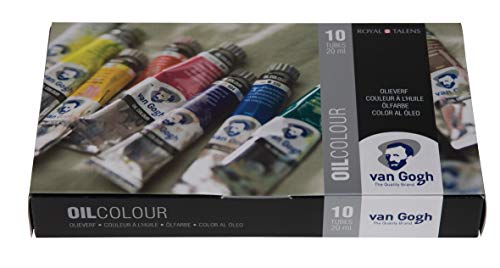Whether you are just exploring oils for the very first time or perhaps are a professional artist looking to change things up, the oil paint that you decide to add to your studio can make a measured impact on variety of factors.
From the vibrancy of the pigment itself all the way to the consistency, the best oil paint can draw out your finest qualities as an artist.
While we reviewed some of the same oil paints that were used by the great artists like Picasso, Cezanne, and Matisse, we also took a look at much more modern oils that have been formulated in the past few years.
Table of Contents
Comparing All The Best Oil Paints
Here’s a table that includes info on both price as well as color charts for easier comparison:
The Best Oil Paints Reviewed
1. Winsor & Newton Winton Oil Color Paint
Winsor & Newton’s Winton line of oil paints is found in many art classrooms across the country.
This affordable, yet well performing oil paint has the perfect consistency that isn’t too terribly intimidating for beginners.
Not only can you find Winsor & Newton oil paints stocked regularly at online stores like Amazon and Blick Art Materials, but you can even find this line at your local art and craft stores.
With 47 different colors (their professional line has 80), you have a fairly wide selection to go between when planning your next piece – especially for a student level set.
Given that this is a student oil paint, it does contain linseed oil as the binding agent that holds the pigment – therefore, over several decades, it may begin to yellow. Likely not a huge deal if you are a student learning for the first time, but for commissioned pieces, it’s an important point.
For those artists that are looking to learn about the Winton’s lightfastness and permanence rating, check out the Winsor & Newton website – there you can see details for every one of their 47 oil paints:
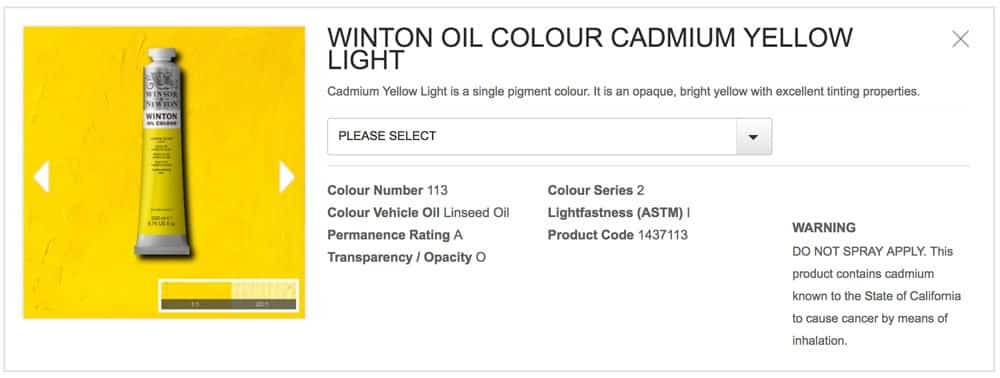
You can even see the transparency / opacity information as well.
While a slightly higher price compared to some other bargain finds elsewhere, if you are serious about learning art, the Winton’s are a great pick.
Pros
- Great beginner oil paint
- Slightly stiff consistency
- Lightfastness / permanence rating easy to find online
- Fairly wide color selection (48)
Cons
- Linseed oil base may yellow with time
2. Williamsburg Oil Traditional Colors Set
A maker of fine oil paints since 1980, this Williamsburg, Brooklyn based company was there before it became the unofficial art capital of the world.
While they have since been acquired by Golden (source), Williamsburg is still making their oils by hand.
These slightly gritty oils provide a level of texture that many professional artists may seek out.
But texture alone isn’t the best part of these oils.
Like any true artist grade oil, they also feature one of the widest color selections you can find (185 in total)!
This not only gives you unparalleled brightness and vibrancy in your artwork, but the ability to be as expressive as possible.
For those artists who like to find the lightfastness ratings, opacity, and even a bit more about the paint – their color chart is incredibly detailed:
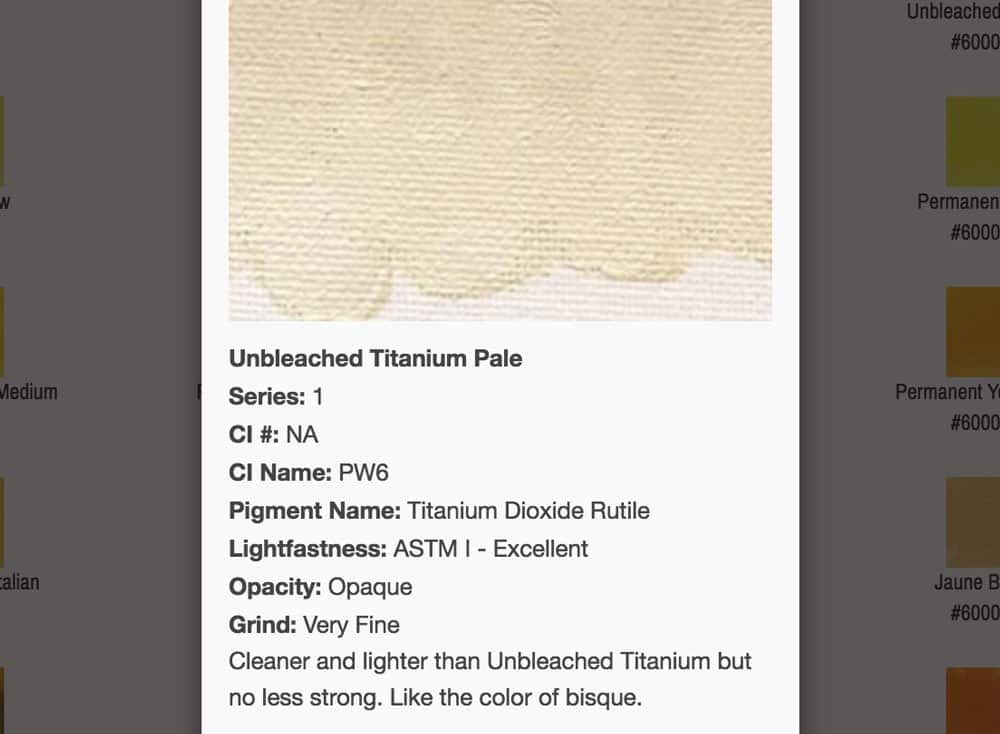
While we only took a look at their traditional colors set, Williamsburg does make color specific sets as well – which include the following:
- French Earth
- Intro
- Iridescent
- Landscapes
- Modern
- Native Italian
- Signature
While priced at a premium, these oils make for both an excellent artist grade paint and even a nicer gift.
Pros
- Massive color selection
- Established brand
- Great color chart
Cons
- Some paints have a gritty texture (highly subjective)
- Expensive
3. Sennelier Artist Oils

When you use the same oil paint that has been favored by the greatest artists ever, including Monet, Gauguin, Picasso, Matisse, Hockney, and Ernst to name just a few, you really have no basis for comparison.
Makers of fine art supplies for over 130 years, Paris based Sennelier, which still has a store located between both Musee d’Orsay and The Louvre – you can’t get any more authentic than this.
Made from non-yellowing safflower oil that features a butter-like consistency, these oil paints are a high pigment loaded paint that delivers on all the best characteristics you would ever need.
With nearly every single one of their paints delivering a lightfastness rating of I (able to withstand 100 years without losing its vibrancy) – their archival qualities are second to none.
In this 8-piece (40 ml) starter set, you have access to all the essentials:
- Titanium White
- Cadmium Yellow Light
- Chinese Orange
- Cadmium Red Light
- Alizarin Crimson
- Azure Blue
- French Ultramarine
- Yellow Ochre
Now if you aren’t ready to pay the ~$100 price for this box, you can find these oils individually at Blick Art Materials.
With 144 colors available, you should have no problem finding the perfect paint for your next piece of work.
Pros
- Use by the best painters of our time
- Uncompromising quality
- Excellent lightfastness ratings
Cons
- Expensive
4. Van Gogh Oil Colors
Highly respected in the world of many different mediums including acrylics, watercolors, and now oils are the Van Gogh brand made by Royal Talens.
Now normally when you see an artist’s name (especially one so revered as Van Gogh) associated with a brand, you may think it will be overpriced and provide lackluster results.
However, that couldn’t be further from the truth with these student grade oil paints.
With the 66 colors in total, they exceed all expectations in both lightfastness and permanence. 47 colors in this line have an excellent lightfastness rating of I, therefore they won’t degrade when on display for over 100 years!
The other 19 colors have a very good lightfastness rating of II (withstand 50 to 100 years on display with no color degradation).
This is due in large part to the high pigment concentration and pure ingredients found in each one of their tubes.
To look up each paints rating, check out this color chart on the Royal Talens website.
Their starter set is well rounded and contains 10 colors:
- Titanium White
- Azo Yellow Light
- Azo Yellow Deep
- Azo Red Medium
- Quinacridone Rose
- Ultramarine
- Cerulean Blue Phthalo
- Permanent Green Deep
- Burnt Umber
- Ivory Black
You not only have the primary colors covered, but many additional colors such as burnt umber, ivory black, and titanium white to further alter the tint.
While the tubes in this set are at a much smaller 20 ml – the pigment strength is so strong that you shouldn’t have to worry about refilling immediately.
However, once you have fully gone through a tube, you can purchase 40 ml or 200 ml tubes individually from Blick Art Materials.
Overall, these are a great student/intermediary oil paint set that demonstrates some of the best features usually reserved for artist grade paints.
Pros
- Terrific lightfastness ratings
- High pigment concentration
- Can purchase individually
Cons
- Is a bit pricey
5. Gamblin 1980 Oil Color Set
While most oil painters know of Gamblin through their highly-touted Gamsol (OMS solvent) and Galkyd (their fast-drying medium), their 1980 oil color set is dubbed as being a “high-end student grade oil”.
This set (pictured above), contains 8 (37ml) tubes of oil – that are perfect for getting you started. The colors contained in this set are as follows:
- Alizarin Crimson
- Cadmium Red Light
- Cadmium Yellow Light
- Yellow Ochre
- Ultramarine Blue
- Phthalo Green
- Titanium White
- Ivory Black
Like the Van Gogh set, these are all the colors you need to mix just about anything you could possibly want.
While we found it lacking that Gamblin doesn’t include a lightfastness and permanence rating for their oils (perhaps due to its student grade nature), we were able to locate both the pigments used and transparency ratings for each oil they make – view here.
Of the 48 colors Gamblin produces, more than half (30), are produced from a single pigment source – making for much more vibrant and brighter colors than most.
Refined linseed oil is used as the base for these paints, so expect to see some yellowing of the colors after several years.
Should a set not be what you are looking for, Gamblin does sell these tubes individually as well on both Amazon and on the Blick Art Materials website.
Pros
- Student grade paints
- Affordable
- Made in USA
- Great consistency / texture
Cons
- Lightfastness ratings missing
6. Blockx Oil Paint
Belgium based Blockx has been making oil paints since 1865.
Absent of any additives or other fillers, these artist grade oil paints are just about as pure as they come.
Sold individually rather than a set, you can find most of the Blockx colors in either a 35 ml or 200 ml tube – with some 200 ml tubes priced as high as $181 for a single tube.
This makes the 35 ml option great for trying out the color without breaking the bank.
As one of the highest rated oil paints on the Blick Art Materials website (at the time of publishing it had a perfect 5.0 rating based on 43 reviews), we think you will love the results and are worth every penny.
With nearly every oil paint receiving an excellent lightfastness rating, like the Sennelier, these are artist grade paints that will look amazing years after you set down the brush.
For a full look at their lightfastness and permanence ratings – check out the Blockx site for more info.
Pros
- Artist grade quality
- Excellent lightfastness
- Very fine
- Consistent pigment load
Cons
- Expensive
7. Michael Harding Starter Set
It’s not often that you find an artist that is also the creator behind a wildly popular oil paint brand – but such is the case with these paints from Michael Harding.
Set out on a mission in 1982 to recreate the same vibrant colors found in Rembrandt paintings, Michael Harding has achieved the highest of respect from his peers with his line of artist grade paints.
As an artist, Michael Harding’s website understands what’s important to you, and has everything laid out in an easy to read and understandable manner.
When looking at the color chart of their entire line of oils, you can select and see all the important information:
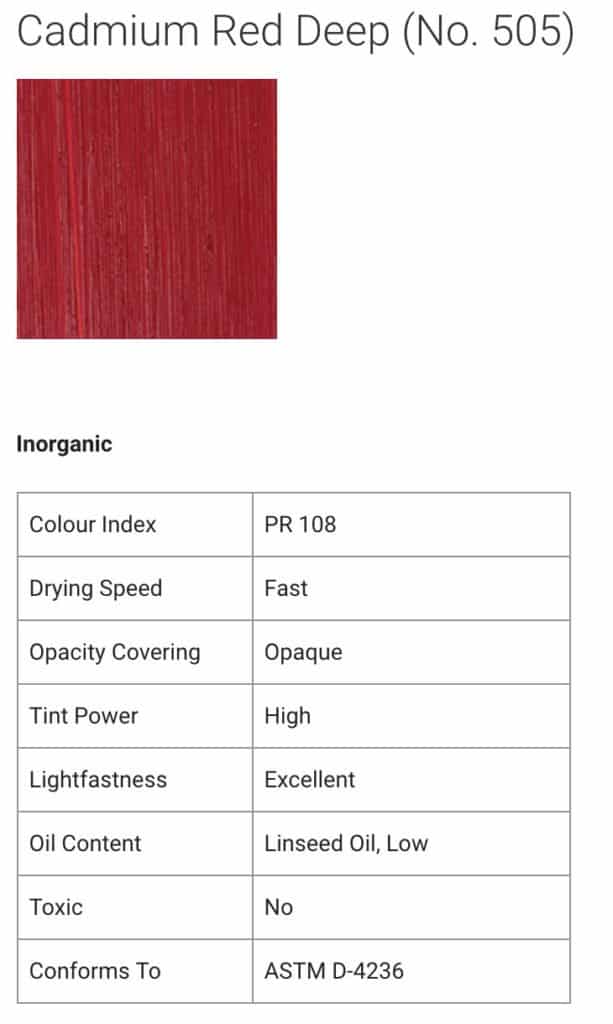
Available in 40 ml, 60 ml, and 225 ml tubes – you can explore the line and purchase the right amount for an upcoming piece.
The starter set (pictured above), has all the primaries to give you a wide range for color mixing:
- Titanium White No.2
- Ultramarine Blue
- Scarlet Lake
- Yellow Lake
- Yellow Ochre Deep
- Burnt Umber
While some of these paints can cost upwards to $400 for a single tube, the intro set is a great gateway into a much larger world of high end oils.
To see these oils in application, take a minute to watch this video by British plein air artist Vicki Norman:
Pros
- Artist founded company
- Best color chart available
- Silky consistency
Cons
- Long drying times (due to pure ingredients)
- Very expensive
8. Schmincke Mussini Oil
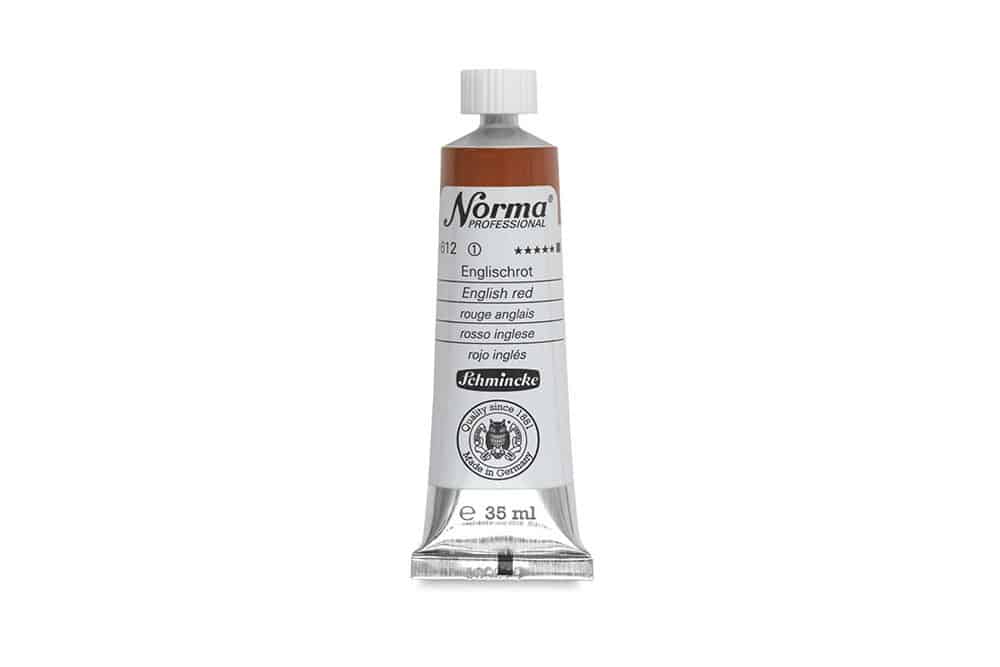
Known widely for their fine watercolors, Schmincke is a German based maker of art supplies primarily geared towards professional level artists.
Their Mussini line of 108 colors (64 single pigment), are a vibrant and slow drying medium that oil painters love.
Based on either linseed, safflower, or poppy seed oils, these artist grade oils resist yellowing while still having a body that can be reworked easily.
For those artists that love to see the particular ratings and opacity / transparency of the paints before you make a purchase – Schmincke makes an easy-to-read color chart available on their website that’s worth checking out.
Pros
- Vibrant results
- Deep / saturated colors
- Affordable for an artist grade paint
- Smooth consistency
Cons
- Hard to find in stores
9. Old Holland
The oldest art supply company in the world, Old Holland got their start in 1664 (source)!
There’s a reason that they have been around for over 350 years – they simply know how to serve artists of any generation extremely well.
With artist grade supplies that deliver a buttery consistency that’s both vibrant and an excellent lightfastness rating – you can see why they are still good even by today’s standards.
With 168 colors available, nearly the widest selection on the market, you can get vibrant pigments in your artwork in either a 40 ml, 125 ml, or 225 ml tube.
For an artist grade paint, its moderately priced. While not offering any $400 tubes of paint like the Michael Harding’s – Old Holland typically hovers between $10 to $200 for a single tube.
Making it a great pick for those professional artists starting to make a name for themselves.
Lightfastness and other details are available for any one of the 168 colors on the Old Holland website:
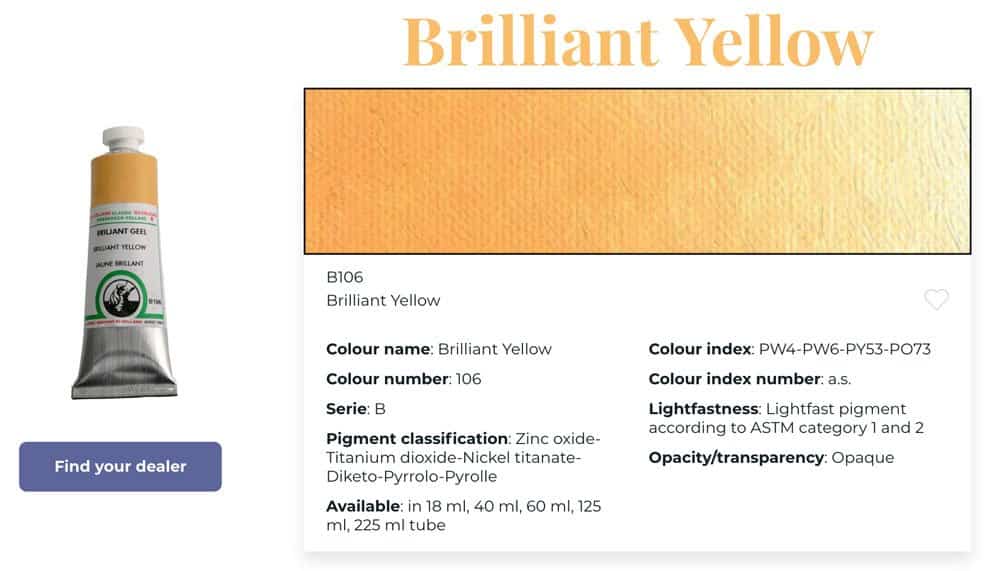
If you are looking to upgrade form your favorite Winsor & Newton Winton’s or perhaps the Gamblin 1980s – then Old Holland is worth considering.
Pros
- Wide color & size selection
- Easy to use color chart
- Moderately priced
- Oldest art supply company in existence
Cons
- Might not be as vibrant as other professional grades
10. M. Graham 5-Color Oil Set
The buttery and solvent-free paints by M. Graham are a brilliant and vibrant oil paint perfect for professional level artists.
With a walnut oil base (as opposed to linseed oil), along with a solvent-free body, they are a slow drying oil paint that is great for artists who do multi-day paintings and like to still have the ability to move around the medium.
This USA based company (Oregon), is extremely transparent in their production process as evident in their captivating video walking you through how their paint is made. If you have a few extra minutes, it’s worth checking out:
With 75 different colors, the selection is a bit limited – especially compared to the Williamsburg or Sennelier brand.
But given that this was their 25th anniversary, M. Graham just added 25 new colors to their lineup.
Pros
- Slow drying walnut oil base
- Vibrant results
- Resists yellowing
- Made in USA
Cons
- Limited color selection compared to others
11. Bob Ross Artist Oil Color
If you aren’t watching the Bob Ross channel on Twitch, you are missing out.
There you can see him not only teach you a thing or two when it comes to painting beautiful landscapes, but also perhaps see a happy little tree or two!
But as beginner friendly as Bob Ross is, his oil colors mean serious business.
With artist grade materials that rivals even the biggest and oldest names in the world of high end art supplies – these moderately priced oils are great for both student and intermediate level artists.
With a pigment rich base, these were made to really showcase that trademark wet-on-wet technique that Bob Ross often employed in his show.
The consistency of these oils is extremely soft – making mixing between the oils extremely easy.
Pros
- Beginner friendly
- Butter consistency
- Intense colors
Cons
- Limited color selection
12. Winsor & Newton Artist Oils
A step up from the Winton oils, you will find the Winsor & Newton Artist Oils.
At a much richer pigment concentration, these oils are great for those artists ready to graduate from the student grade materials.
In the professional line of oils, Winsor & Newton offers up a total of 120 different colors. Of the 120, 80 rely on just a single pigment source.
This will result in much vibrant and consistent colors when used in your artwork.
In addition, when a single pigment source is used, you will have near perfectly matching colors when an oil paint is refilled.
While still having a slightly stiffer body like the Winton’s – artists can develop up additional layer to make a semi-impasto piece.
Of all the artist grade oils featured on our list, these are by far one of the cheaper picks with a price per tube (200 ml) typically costing between $23 and $55.
Lastly, for the artists looking for details around lightfastness and permanence, Winsor & Newton has it all clearly displayed on their website.
Pros
- Affordable artist grade paints
- Wide color selection
- 2 sizes available
- Inexpensive
Cons
- Body may be a bit too stiff for some
Key Differences Between Student And Artist Grade Paints

As you found out, the differences between both beginner and artist grade paints is massive.
From the vibrancy, composition, consistency, and lightfastness they all are important factors when deciding which oil paint you should go with.
Here’s a brief breakdown on all the key points:
Vibrancy / Brightness
The largest difference between student and artist grade paints will be their vibrancy or brightness. Artist grade paints are often made from a pure single pigment source – which makes for much brighter and vivid colors.
Oil paints that are a mix between the two will lose their luster and may not have an even mix – with the latter largely being dependent on how good the company’s production process is.
Composition
Related to the pigment sourced for the oil paint, companies may include many fillers and extenders to lower the amount of overall pigment used.
This problem can be twofold:
Not only can it further dull the colors, but it can lead to yellowing, cracking, or chipping of the paint over time.
Artist grade paints typically won’t be loaded up with this extra junk – ultimately increasing the price per tube.
Student grade oil paints however, often contain this extra stuff.
While not necessarily bad, it’s important to remember that student grade paints are used for learning, not for finished pieces that are to be displayed.
Consistency
This is largely personal preference, as some artists may prefer a more ‘grainy’ textured paint to one that is creamy or buttery.
Depending on the supporting mediums (if any) you like to use in your artwork can dictate the type of oil paint you decide to go with.
Many artists found that the Williamsburg Oils gravitated towards grainy, while French based Sennelier were a bit more fluid.
Winsor & Newton paints (both the Winton’s & Artist Oils) had a rather stiff body.
Again, this is a personal preference.
Lightfastness
This deals with out well the paint will preserve its colors when exposed to UV light under normal conditions.
The ratings you see for paints are determined by ASTM D4303 – therefore ratings are brand agnostic.
Nearly all artist grade paints will have a lightfastness rating between I – III (with I being the highest).
Here’s a general idea of when you should expect the paint to begin to fade over time based on lightfastness rating:
I. Excellent lightfastness – over 100 years
II. Very good lightfastness – 50 to 100 years
III. Fair lightfastness – 15 to 50 years
IV. Poor lightfastness – 2 to 15 years
V. Very poor lightfastness – less than 2 years
Of course, paint mixes, varnish, and various mediums can have an impact on the above ranges.
Which One Should You Get?

As you can see from the reviews, deciding between oil paints can be a challenge.
With companies like Michael Harding demanding up to $400 for a single tube of oil paint – you don’t want to needlessly waste money.
Therefore, our general guidelines that we recommend for artists is as follows:
If you aren’t making a living and getting paid to make the painting, then don’t splurge on a high-priced artist grade paint.
Now, if you are lucky to have extra money lying about, then sure – go for it.
Test it out, get a small tube, and see just how great it is.
Switching from student to artist grade oil paints is night and day. The color vibrancy, consistency, and general overall quality is insurmountably better.
Now if you are a student in art school, or perhaps paint more as a hobby, then student grade paints will be more than sufficient.
While student grades oils can achieve some good colors without being too dull or grey, they are designed for learning.
In addition, if you are just trying out oil painting and not sure if its right for you, then a set like the Windsor & Newton Winton Oils or the Gamblin 1980’s are perfect starters that contain the primary colors to theoretically mix any color you could want.
Don’t Forget The Brush
While we don’t want to go too far beyond the scope of today’s article, we do want to stress that all the oil paints listed above don’t include a brush, palette, or canvas!
So if you are picking up painting for the very first time, don’t forget to add a quality oil paint brush, canvas, and a palette for mixing.
Essential Mediums You Should Own
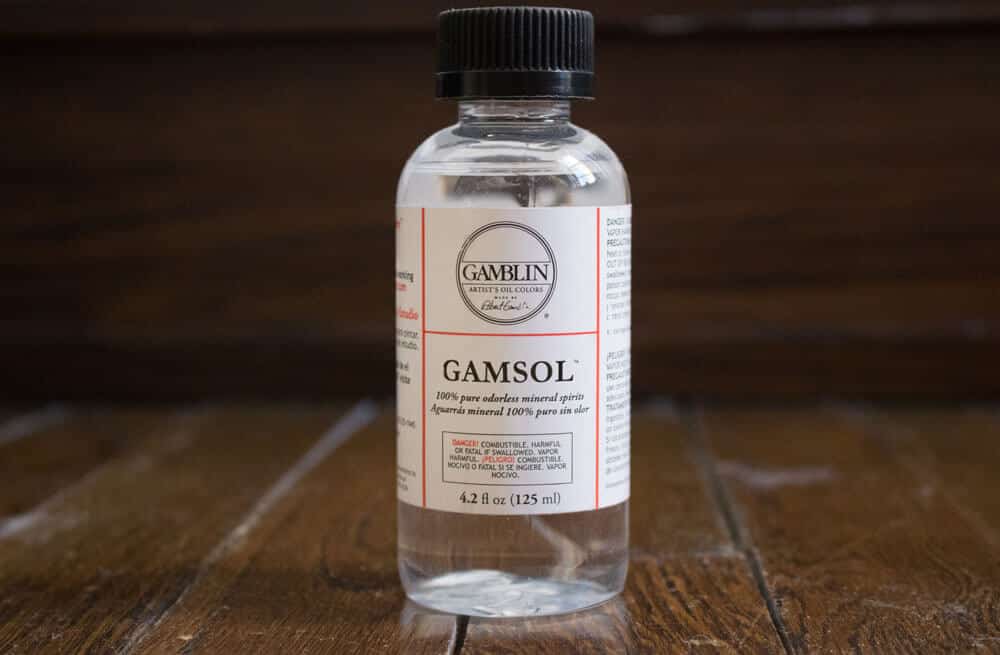
In order to both clean your brushes and manipulate this timeless medium, you will need to also rely on a solvent.
Solvents like odorless mineral spirits and turpentine help to break down the bonds between the linseed oil and pigment within the oil paint itself.
It can be great for thinning out the paint in order to get an initial wash for your piece.
For students and beginners we like recommending Gamsol as its truly odorless and great for starting out.
Opposite of solvents, you can use extenders like linseed oil that help to lengthen drying times while making the paint last a little bit longer (a great way to save money).
Choosing The Best Oil Paints For Beginners And Professional Artists
Deciding the absolute best paint for both student and professional artists proved to be a challenge. With so many companies making great oil paint today, the decision process was tough – but a great problem to have.
We are confident that we found the best ones that will work for nearly all the artists reading.
Given that we didn’t have the resources to look at every single oil paint on the market, there may be a few you want us to review. If this is the case, please get in contact with us and let us know.
As we like to remind all artists on this site, quality art supplies are important to helping you get better, but it’s not the most important aspect.
Regular practice beats all.
So be sure to get in the studio daily and always push yourself to look at paintings differently – before you know it, you might find your way into a few Art History books yourself!


